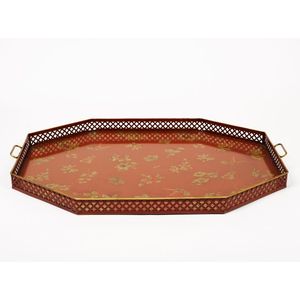George III Mahogany and Satinwood Foldover Card Table
You must be a subscriber, and be logged in to view price and dealer details.
Subscribe Now to view actual auction price for this item
When you subscribe, you have the option of setting the currency in which to display prices to $Au, $US, $NZ or Stg.
- Castors - Wheels, fitted especially to chair legs, couches, tables and some smaller pieces of furniture, to enable them to be easily moved about. The earliest castors were of brass, with shanks fitting into the base of the leg, and the wheels often made of leather. In the late 18th century, brass 'bucket' or 'cup' castors were introduced, either rounded or square, fitting directly over the end of the leg and held in place with screws. The wheels were generally solid brass. Bucket/cup castors continued in use throughout the 19th century and indeed are still made today. In the later 19th century wheels were sometimes made of wood, china, either white or brown, and sometimes of steel.
- Mahogany - Mahogany is a dense, close grained red-coloured timber from the West Indies and Central America. It was first imported into Europe in the the early 18th century and its use continued through the 19th century. It was popular for furniture making because of its strength, the wide boards available, the distinctive grain on some boards, termed flame mahogany and the rich warm colour of the timber when it was polished.. The "flame" was produced where a limb grew out from the trunk of the tree, and this timber was usually sliced into veneers for feature panels on doors, backs and cornices.
Some terms used to describe mahogany relate to the country from which it originally came, such as "Cuban" mahogany, "Honduras" mahogany etc. However unless the wood has been tested the names assigned are more a selling feature, rather than a true indication of the timber's origin. - Foldover - A term used when describing card, tea or games tables, where the top folds over onto itself when not in use. The interior surfaces that are exposed when the top is open may be polished (in the case of tea tables) or baized (for card or games tables).
- Patera - A small decorative device, used as ornament in Neo-classical style furniture. Patera (or paterae) are usually round or oval, in the form of stylized rosettes. In the best pieces they are carved directly into the timber, otherwise they applied to the surface. Sometimes painted or inlaid motifs in the style are referred to as patera. Also known as a boss or a rosette.
- Crossbanding - Crossbanding is a decorative technique used in furniture-making, where thin strips of wood, known as crossbands, are applied to the surface of a piece of furniture to create a decorative border or inlay. The crossbands are typically made of a different type of wood or a different color than the main piece of furniture, and are applied in a geometric pattern, such as a checkerboard or herringbone design.
Crossbanding was a popular decorative technique in furniture-making from the 17th to the 19th centuries, particularly in the Baroque, Rococo, and Chippendale styles. It was often used to create intricate patterns and designs on the surfaces of tables, desks, cabinets, and other pieces of furniture. The crossbands were often made of exotic woods, such as ebony or rosewood, which were imported from other parts of the world and were highly prized for their rich colors and patterns. - Satinwood - Satinwood is a dense pale gold coloured timber that was imported into Britain in the second half of the 18th century, and early 19th centuries from the East Indies and the West Indies. The name derives from the satin-like surface sheen when the timber is polished.
It was used in the solid, as a veneer and in inlays. As well as furniture, satinwood was used for making musical instruments, barometers, boxes and clocks.
It will usually be found on only the very best quality objects, presumably because of of its cost at the time. - George Iii - George III (1738 - 1820) was King of Great Britain and Ireland from 1760 to 1820.
- Frieze - An architectural term denoting the flat, shaped or convex horizontal surface of furniture, between the architrave and the cornice, usually found on a cabinet or bookcase, or on desks and tables where it may include drawers, the area between the top and the legs. In ceramics, the term refers to the banding, of usually a repeating pattern, on the rims of plates and vases.
- Inlay - Decorative patterns inserted into the main body of a piece of furniture, generally in wood of contrasting colour and grain, though brass, ivory, ebony, shell and sometimes horn have been used. Inlay may consist of a panel of well figured timber inset into a cabinet door front, geometric patterns, or complex and stylized designs of flowers, swags of foliage, fruits and other motifs. As a general rule, in pieces where the carcase is constructed in the solid, the inlay is relatively simple such as stringing, cross banding and herringbone banding. Where more elaborate and decorative work was required veneer was used. Inlay has been fashionable from at least the latter half of the 17th century, when a variety of elaborate forms were developed
This item has been included into following indexes:
Visually similar items

Soro Stolefabrik, ebonised rocking chair with woven seagrass seat

A pair of tinted Chinese ivory carvings, carved almost symmetrically with children playing various games amongst a garden pavilion, each carved with pine trees and willows to its back, 11 cm high, (2).

Large toleware tray with pierced gallery, painted red and gold. Width 78 cm depth 59 cm Provenance: Brook Street Trading, Woollahra

Marlon Brando (1924-2004, Academy Award-winning actor), signed photo from 'The Godfather'
